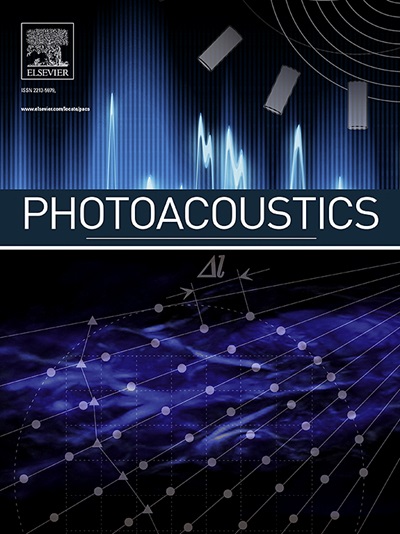Muscle oxygen saturation stratification by photoacoustic imaging in diabetic sarcopenia: Association with disease status
IF 6.8
1区 医学
Q1 ENGINEERING, BIOMEDICAL
引用次数: 0
Abstract
Sarcopenia, commonly observed in diabetes, is characterized by reduced muscle mass and function. However, the relationship between muscle oxygen saturation (SO₂) and sarcopenia remains unclear. Photoacoustic imaging (PAI) offers a promising method for assessment. This study aimed to evaluate SO₂ distribution in diabetic sarcopenic patients using PAI and explore associations with clinical parameters. Type 2 diabetes patients (≥ 10 years) underwent PAI of the gastrocnemius and vastus lateralis muscles. Sarcopenia was diagnosed by AWGS 2019/2020 criteria. SO₂ values stratified patients into hypoxia, intermediate, and hyperoxia groups. The study included 64 sarcopenic and 115 non-sarcopenic patients. Mean SO₂ was significantly lower in sarcopenia (63.28 % vs. 66.26 %, P < 0.001). PAI-measured SO₂ was an independent protective factor (β = −0.10, P = 0.001). In conclusion, PAI-assessed SO₂ is associated with sarcopenia and may serve as an early screening biomarker.
糖尿病性肌肉减少症的光声成像肌肉氧饱和度分层:与疾病状态的关系
肌肉减少症常见于糖尿病,其特征是肌肉质量和功能减少。然而,肌氧饱和度(SO₂)与肌肉减少症之间的关系尚不清楚。光声成像(PAI)是一种很有前途的评估方法。本研究旨在利用PAI评估糖尿病肌减少症患者的SO₂分布,并探讨其与临床参数的关系。2型糖尿病患者(≥10岁)行腓肠肌和股外侧肌PAI。骨骼肌减少症根据AWGS 2019/2020标准诊断。so2值将患者分为低氧组、中度组和高氧组。该研究包括64名肌肉减少症患者和115名非肌肉减少症患者。肌肉减少症患者的平均SO₂显著降低(63.28 %比66.26 %,P <; 0.001)。pai测量的so2是独立的保护因素(β =−0.10,P = 0.001)。总之,pai评估的SO₂与肌肉减少症有关,可以作为早期筛查的生物标志物。
本文章由计算机程序翻译,如有差异,请以英文原文为准。
求助全文
约1分钟内获得全文
求助全文
来源期刊

Photoacoustics
Physics and Astronomy-Atomic and Molecular Physics, and Optics
CiteScore
11.40
自引率
16.50%
发文量
96
审稿时长
53 days
期刊介绍:
The open access Photoacoustics journal (PACS) aims to publish original research and review contributions in the field of photoacoustics-optoacoustics-thermoacoustics. This field utilizes acoustical and ultrasonic phenomena excited by electromagnetic radiation for the detection, visualization, and characterization of various materials and biological tissues, including living organisms.
Recent advancements in laser technologies, ultrasound detection approaches, inverse theory, and fast reconstruction algorithms have greatly supported the rapid progress in this field. The unique contrast provided by molecular absorption in photoacoustic-optoacoustic-thermoacoustic methods has allowed for addressing unmet biological and medical needs such as pre-clinical research, clinical imaging of vasculature, tissue and disease physiology, drug efficacy, surgery guidance, and therapy monitoring.
Applications of this field encompass a wide range of medical imaging and sensing applications, including cancer, vascular diseases, brain neurophysiology, ophthalmology, and diabetes. Moreover, photoacoustics-optoacoustics-thermoacoustics is a multidisciplinary field, with contributions from chemistry and nanotechnology, where novel materials such as biodegradable nanoparticles, organic dyes, targeted agents, theranostic probes, and genetically expressed markers are being actively developed.
These advanced materials have significantly improved the signal-to-noise ratio and tissue contrast in photoacoustic methods.
 求助内容:
求助内容: 应助结果提醒方式:
应助结果提醒方式:


